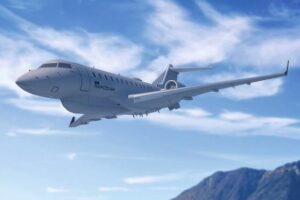The Army has awarded its ATHENA-S intelligence, surveillance and reconnaissance (ISR) jet program contract to Sierra Nevada Corporation (SNC), a lead official confirmed Tuesday.
Rodney Davis, the Army’s acting program executive officer for aviation, said SNC received the ATHENA-S award in late September, adding he believes it will take “at least a year” before it starts flying.

ATHENA-S is intended to serve as a bridge capability to ultimately inform final requirements for the Army’s future HADES, or High Accuracy Detection and Exploitation System, aerial ISR program of record.
SNC’s RAPCON-X offering for ATHENA-S was a Bombardier Global 6500 jet outfitted with radars and signals intelligence systems, with the company previously citing its emphasis on open architecture and model-based systems engineering for rapid mission reconfiguration and designed to operate within the future JADC2 framework (Defense Daily, April 13 2022).
Leidos [LDOS] and L3Harris Technologies [LHX] announced in July they had teamed up to pursue ATHENA-S, also offering modified Global 6500 jets, while ultimately losing out to SNC’s bid.
Both Leidos and L3Harris are currently involved in separate Army fixed-wing ISR programs, with the former outfitting a Bombardier Challenger 650 for the ARTEMIS effort and the latter working on the Airborne Reconnaissance and Electronic Warfare System, or ARES, program in support of U.S. Indo-Pacific Command.
Tim Owings, executive vice president for SNC’s mission solutions and technologies business area, previously told Defense Daily the company’s work to date on the Global 6500 jets at its Hagerstown, Maryland facility would allow for an accelerated delivery schedule with the Army (Defense Daily, July 26).
“We’re hoping and planning on winning that in September. And as the RFP has laid out, it calls for delivery within 12 months. I’m confident we will beat that by a lot just because of how far on that with our engineering, our kitting and everything else we’ve got ready to go,” Owings said at the time.
SNC’s ISR jets for ATHENA-S will be provided as a contractor-owned and operated service, Davis noted on Tuesday, while he did not disclose the value of the contract award.
“For very specialized missions, [the customer] doesn’t want to have to train a lot of soldiers to be able to do those missions. So what we do is we’ll operate the mission. We’ll provide the data back to them. They’ll do the things that are uniquely military, but we’ll provide that as a service to them so they’re not having to deal with maintenance of the aircraft, training people for that, training people for operating very specific signals intelligence sensors,” Owings has said previously.
SNC also previously pursued the Army’s separate ATHENA-R program, which focused on integrating Northrop Grumman’s [NOC] Long Range Radar, but lost out on that effort earlier this year to a team of MAG Aerospace and L3Harris.
Owings has said the RAPCON-X proposed for ATHENA-S would require “minimal changes” to meet the likely requirements for the future HADES program.
“We’ll use much of that design [from ATHENA-S], there will be some slight changes depending on the different equipment as required by the Army, but the exterior mold line, the interior mold line and the digital backbone will all be the same. The airplane was designed to be ‘future-proofed,’ in that it won’t take a lot of rework to modify what’s going to be flown on the airplane,” Owings has previously told Defense Daily.